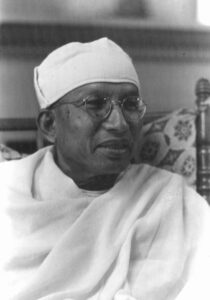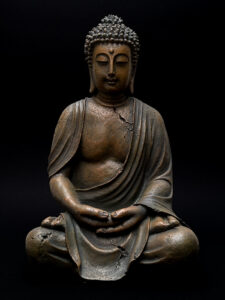“Be simple & easy. Take things as they come” Teachings from Anagarika Munindra
A reflection on practice by Other Teachers & Folks We Value
Indian Vipassana meditation teacher Anagarika Munindra (1915-2003) played a pivotal role in transmission of Buddhism from East to West. He was a significant teacher for many notable meditation teachers, including Joseph Goldstein, Sharon Salzberg, Dipa Ma, Kamala Masters & Surya Das. Munindra highlighted simplicity & ease. Joseph Goldstein says he must have repeated thousands of times, “Be simple & easy. Take things as they come.”
Quotes here from Munindra come from LIVING THIS LIFE FULLY, by Mirka Knaster.
 “Everything is meditation in this practice, even while eating, drinking, dressing, seeing, hearing, smelling, tasting, touching, thinking. Whatever you are doing, everything should be done mindfully, dynamically, with totality, completeness, thoroughness. Then it becomes meditation, meaningful, purposeful. It is not thinking, but experiencing from moment to moment, living from moment to moment, without clinging, without condemning, without judging, without evaluating, without comparing, without selecting, without criticizing—choiceless awareness.
“Everything is meditation in this practice, even while eating, drinking, dressing, seeing, hearing, smelling, tasting, touching, thinking. Whatever you are doing, everything should be done mindfully, dynamically, with totality, completeness, thoroughness. Then it becomes meditation, meaningful, purposeful. It is not thinking, but experiencing from moment to moment, living from moment to moment, without clinging, without condemning, without judging, without evaluating, without comparing, without selecting, without criticizing—choiceless awareness.
“Meditation is not only sitting; it is a way of living. It should be integrated with our whole life. It is actually an education in how to see, how to hear, how to smell, how to eat, how to drink, how to walk with full awareness. To develop mindfulness is the most important factor in the process of awakening.”
* * * * *
“Death I don’t mind. Every moment we are dying. Everything is impermanent. Who is dying? There is nobody dying. It is just a process. This is merely a law of nature… everything in nature is arising & vanishing. There is nothing to be afraid of. In death also, smiling you can go. Every moment we are dying. Once you are acquainted with this, then it is simple.”
* * * * *
“Unpleasant feelings are most prominent to us because, when we experience pleasant feelings, we don’t mind. But when we experience the  unpleasant feeling, we don’t like it & we condemn. We have to observe it. We have to penetrate it. We have to pierce through it. We have to understand it. When you keep the mind there, then you will see that it is not static; it is a process, and afterward, it disappears. But don’t expect it to come or to go. If you expect, then you have to be aware of the expecting mind. Not clinging, not condemning, not hoping. Whatever comes up, see the thing as it is, at this moment, without liking or disliking. If you like it, you feed it with greed; if you dislike it, you feed it with hatred. Both ways, the mind is unbalanced, unhealthy, unsound. [The] object itself is neither good nor bad. It is our mind which attributes the color—it is good or it is bad. We are influenced by that & then reaction comes. Be gentle with everything that comes up. Keep the mind in a balanced state. We are following the middle path. Be fully alert.”
unpleasant feeling, we don’t like it & we condemn. We have to observe it. We have to penetrate it. We have to pierce through it. We have to understand it. When you keep the mind there, then you will see that it is not static; it is a process, and afterward, it disappears. But don’t expect it to come or to go. If you expect, then you have to be aware of the expecting mind. Not clinging, not condemning, not hoping. Whatever comes up, see the thing as it is, at this moment, without liking or disliking. If you like it, you feed it with greed; if you dislike it, you feed it with hatred. Both ways, the mind is unbalanced, unhealthy, unsound. [The] object itself is neither good nor bad. It is our mind which attributes the color—it is good or it is bad. We are influenced by that & then reaction comes. Be gentle with everything that comes up. Keep the mind in a balanced state. We are following the middle path. Be fully alert.”
* * * * *
“Mind by nature has no color. When it is colored with greed, we call it “greedy mind.” When anger arises, at that moment, it is called “angry mind.” If there is no mindfulness, mind is influenced by this anger. Anger has the nature to pollute the mind; it creates poison. But mind is not anger; anger is not mind. Mind is not greed; greed is not mind. Please remember this. Mind has no nature of liking or disliking. “Mind” means “knowing faculty,” “cognizing faculty.” …Mindfulness is a different thing: alertness, awareness, remembering, heedfulness. It means not to forget, just to be aware, to be mindful of what is going on. When you are asked to walk on a one-bamboo bridge over the river, you have to be so careful on every step. Once you forget, there is  every possibility of falling down. If you lose your mindfulness, you will hurt yourself or kill yourself. So, in reality, mindfulness means not to forget what is going on at the present moment – in thought, in word, in deed.”
every possibility of falling down. If you lose your mindfulness, you will hurt yourself or kill yourself. So, in reality, mindfulness means not to forget what is going on at the present moment – in thought, in word, in deed.”
* * * * *
‘If we know how to live at this present moment, mindfully & with virtue (sila), then the next moment comes all right & we build our future. Working in this way, walking on the middle path, leads you toward liberation, total freedom from the cycle of birth & death.”
MORE LINKS:
Listen to some of his recorded Dharma talks on Dharma Seed
Barre Center for Buddhist Studies interview with Mirka Knaster, author of Living this Life Fully
See more about Other Teachers & Folks We Value
